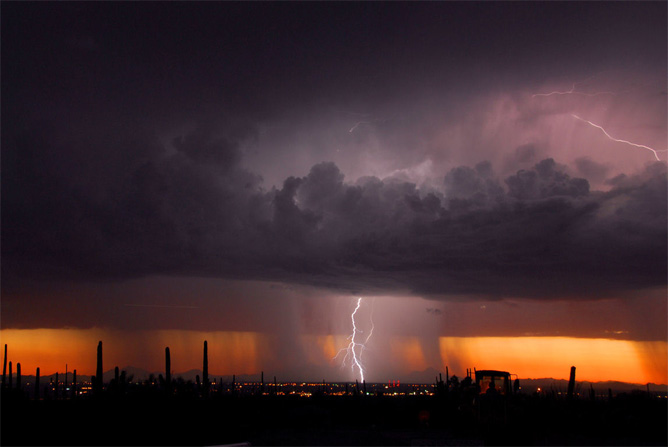Damage Control: Monsoon Season
Aug.05.2013

Repairing your home and backyard following the havoc wreaked by Monsoon season in Arizona
For those of us who live in Arizona, we are fortunate to have plenty of warm, dry weather for the better part of the year. On the other hand, we are not completely immune to bad weather conditions, although many people living in other regions of the country don’t tend to think so. When July is just around the corner, many Arizona residents know it is time to start preparing for those dreaded monsoon storms coming up.
These seasonal storms, commonly referred to as the Monsoon, are caused by atmospheric circulation and precipitation shifts, and are known for bringing a significant amount of rainfall in a very short period of time, not to mention strong winds that can be downright devastating to buildings and landscapes. Flooding is not uncommon, neither is a combination of high humidity and high temperatures during Monsoon season. This is a deadly combination of Mother Nature that lasts approximately two months and brings much needed rainfall to the Arizona desert.
The National Weather Service has in effect determined the dates of Monsoon season to be July 15th through September 30th, though actual wind shifts vary from year to year. At any rate, making sure your property (both inside and out) is properly secured and protected before the weather takes a turn for the worse is essential. Given the damage these heavy Monsoon wind storms have caused historically, there is only so much one you can do, though every effort makes an impact. Doing what you can to forestall the effects will help facilitate the cleanup and repair process. Here are some helpful tips for ensuring your home stays safe from the elements.
Monsoon season safety tips
Place patio furniture inside and safely secure your retractable awnings. Awnings are great for blocking the sun’s harmful UV rays and for creating a comfortable place to relax in the shade, but they are not built to withstand gale force winds, which are common during Monsoon season. Although durable, the fabric covering and metal frame can still be damaged by flying objects. Many companies that sell awnings see a peak in the service and repair side of their business for this very reason. Due to not being properly informed, many home owners fail to appreciate the gravity of the situation. Monsoons are a force to be reckoned with, and cause a considerable amount of property damage every year, which is why homes, including retractable awnings, need to be secured properly.
If your backyard felt the effects of the strong winds and rain-showers, place outdoor flowers and plants in temporary pots until you have restored your yard back to its former state.
Call your local power company if there are downed or damaged power lines on your property; never attempt to remove tree branches or limbs that are in the vicinity of a power line.
If you often see flooding or drainage issues in your yard or around your property, install a drainage system in your yard to prevent it (and your basement) from flooding; this is definitely a worthwhile investment for every Arizona resident.
If a storm is in full force, drive only if you have to. Avoid roadways that are prone to the effects of flash flooding and don’t drive too fast; using common sense and defensive driving techniques will keep you from getting into a car accident. If you happen to be driving when a monsoon storm starts, pull over to the closest available rest stop and wait for the rain to subside. The term “flash flood” is quite accurate; the weather can turn from bad to worse in an instant and people are often caught off guard, so be safe.
Turn off any and all electrical appliances that you don’t need during a monsoon storm; this will help keep your local area from experiencing a power outage. In case one does happen; make sure to have a flashlight with plenty of batteries, as well as several fresh gallons of drinking water on hand.
To find out more about awning repairs, or to learn more about the latest awning technology, contact Mesa Awning Company for more information.
